Spatial Optimization of Agricultural Land Use Based on Cross-Entropy Method
Abstract
:1. Introduction
2. Materials and Methods
2.1. Study Area
2.2. Methods and Data
2.2.1. Evaluation of Crop Planting Suitability
2.2.2. Agricultural Land Use
2.2.3. Gridded Population Data
2.2.4. Optimization Model of Agricultural Cropping Pattern
2.2.5. Spatial Distribution Optimization Model Based on Cross Entropy
3. Results and Discussion
3.1. Crop Demand Assessment
3.2. Crop Comprehensive Suitable Area Distribution
3.3. Comparison of Crop Area Spatial Distribution between Present and Optimal Allocations
4. Conclusions
Acknowledgments
Author Contributions
Conflicts of Interest
References
- Li, M.; Guo, P. A coupled random fuzzy two-stage programming model for crop area optimization—A case study of the middle Heihe River basin, China. Agric. Water Manag. 2015, 155, 53–66. [Google Scholar] [CrossRef]
- Dai, Z.Y.; Li, Y.P. A multistage irrigation water allocation model for agricultural land-use planning under uncertainty. Agric. Water Manag. 2013, 129, 69–79. [Google Scholar] [CrossRef]
- Mianabadi, H.; Mostert, E.; Zarghami, M.; van de Giesen, N. A new bankruptcy method for conflict resolution in water resources allocation. J. Environ. Manag. 2014, 144, 152–159. [Google Scholar] [CrossRef] [PubMed]
- Su, X.; Li, J.; Singh, V.P. Optimal Allocation of Agricultural Water Resources Based on Virtual Water Subdivision in Shiyang River Basin. Water Resour. Manag. 2014, 28, 2243–2257. [Google Scholar] [CrossRef]
- Karimi, M.; Sharifi, M.A.; Mesgari, M.S. Modeling land use interaction using linguistic variables. Int. J. Appl. Earth Obs. Geoinf. 2012, 16, 42–53. [Google Scholar]
- Ma, S.; He, J.; Liu, F.; Yu, Y. Model of urban land-use spatial optimization based on particle swarm optimization algorithm. Trans. Chin. Soc. Agric. Eng. 2010, 26, 321–326. [Google Scholar]
- Pilehforooshha, P.; Karimi, M.; Taleai, M. A GIS-based agricultural land-use allocation model coupling increase and decrease in land demand. Agric. Syst. 2014, 130, 116–125. [Google Scholar] [CrossRef]
- Cao, K.; Ye, X. Coarse-grained parallel genetic algorithm applied to a vector based land use allocation optimization problem: The case study of Tongzhou Newtown, Beijing, China. Stoch. Environ. Res. Risk Assess. 2012, 27, 1133–1142. [Google Scholar]
- Cao, K.; Huang, B.; Wang, S.; Lin, H. Sustainable land use optimization using Boundary-based Fast Genetic Algorithm. Comput. Environ. Urban Syst. 2012, 36, 257–269. [Google Scholar] [CrossRef]
- Baja, S.; Arif, S.; Neswati, R. Developing a User Friendly Decision Tool for Agricultural Land Use Allocation at a Regional Scale. Mod. Appl. Sci. 2017, 11, 11. [Google Scholar] [CrossRef]
- Li, X.; Parrott, L. An improved Genetic Algorithm for spatial optimization of multi-objective and multi-site land use allocation. Comput. Environ. Urban Syst. 2016, 59, 184–194. [Google Scholar] [CrossRef]
- Liu, Y.; Tang, W.; He, J.; Liu, Y.; Ai, T.; Liu, D. A land-use spatial optimization model based on genetic optimization and game theory. Comput. Environ. Urban Syst. 2015, 49, 1–14. [Google Scholar] [CrossRef]
- Maleki, F.; Kazemi, H.; Siahmarguee, A.; Kamkar, B. Development of a land use suitability model for saffron (Crocus sativus L.) cultivation by multi-criteria evaluation and spatial analysis. Ecol. Eng. 2017, 106, 140–153. [Google Scholar] [CrossRef]
- Reshmidevi, T.V.; Eldho, T.I.; Jana, R. A GIS-integrated fuzzy rule-based inference system for land suitability evaluation in agricultural watersheds. Agric. Syst. 2009, 101, 101–109. [Google Scholar] [CrossRef]
- Sorel, L.; Viaud, V.; Durand, P.; Walter, C. Modeling spatio-temporal crop allocation patterns by a stochastic decision tree method, considering agronomic driving factors. Agric. Syst. 2010, 103, 647–655. [Google Scholar] [CrossRef]
- Akıncı, H.; Özalp, A.Y.; Turgut, B. Agricultural land use suitability analysis using GIS and AHP technique. Comput. Electron. Agric. 2013, 97, 71–82. [Google Scholar] [CrossRef]
- Nouri, H.; Mason, R.J.; Moradi, N. Land suitability evaluation for changing spatial organization in Urmia County towards conservation of Urmia Lake. Appl. Geogr. 2017, 81, 1–12. [Google Scholar] [CrossRef]
- You, L.; Wood, S. Assessing the spatial distribution of crop areas using a cross-entropy method. Int. J. Appl. Earth Obs. Geoinf. 2005, 7, 310–323. [Google Scholar] [CrossRef]
- Peng, C. Research on the Optimization of Temporal and Spatial Distribution of Regional Crop Evapotranspiration and Its Application in Middle Reaches of Heihe River; China Agricultural University: Beijing, China, 2016. [Google Scholar]
- Sahoo, B.; Lohani, A.K.; Sahu, R.K. Fuzzy Multiobjective and Linear Programming Based Management Models for Optimal Land-Water-Crop System Planning. Water Resour. Manag. 2006, 20, 931–948. [Google Scholar] [CrossRef]
- Henseler, M.; Wirsig, A.; Herrmann, S.; Krimly, T.; Dabbert, S. Modeling the impact of global change on regional agricultural land use through an activity-based non-linear programming approach. Agric. Syst. 2009, 100, 31–42. [Google Scholar] [CrossRef]
- Sarker, R.; Ray, T. An improved evolutionary algorithm for solving multi-objective crop planning models. Comput. Electron. Agric. 2009, 68, 191–199. [Google Scholar] [CrossRef]
- Niu, G.; Li, Y.P.; Huang, G.H.; Liu, J.; Fan, Y.R. Crop planning and water resource allocation for sustainable development of an irrigation region in China under multiple uncertainties. Agric. Water Manag. 2016, 166, 53–69. [Google Scholar] [CrossRef]
- Biswas, A.; Pal, B.B. Application of fuzzy goal programming technique to land use planning in agricultural system. Omega 2005, 33, 391–398. [Google Scholar] [CrossRef]
- Liu, J.; Li, Y.P.; Huang, G.H.; Zhuang, X.W.; Fu, H.Y. Assessment of uncertainty effects on crop planning and irrigation water supply using a Monte Carlo simulation based dual-interval stochastic programming method. J. Clean. Prod. 2017, 149, 945–967. [Google Scholar] [CrossRef]
- Liu, X.; Ou, J.; Li, X.; Ai, B. Combining system dynamics and hybrid particle swarm optimization for land use allocation. Ecol. Model. 2013, 257, 11–24. [Google Scholar] [CrossRef]
- Liu, Y.; Wang, H.; Ji, Y.; Liu, Z.; Zhao, X. Land use zoning at the county level based on a multi-objective particle swarm optimization algorithm: A case study from Yicheng, China. Int. J. Environ. Res. Public Health 2012, 9, 2801–2826. [Google Scholar] [CrossRef] [PubMed]
- Yu, J.; Chen, Y.; Wu, J. Modeling and implementation of classification rule discovery by ant colony optimisation for spatial land-use suitability assessment. Comput. Environ. Urban Syst. 2011, 35, 308–319. [Google Scholar] [CrossRef]
- Liu, Y.; Yuan, M.; He, J.; Liu, Y. Regional land-use allocation with a spatially explicit genetic algorithm. Landsc. Ecol. Eng. 2014, 11, 209–219. [Google Scholar] [CrossRef]
- Li, X.; Yeh, A.G.-O. Neural-network-based cellular automata for simulating multiple land use changes using GIS. Int. J. Geogr. Inf. Sci. 2002, 16, 323–343. [Google Scholar] [CrossRef]
- Kullback, S.; Leibler, R.A. On information and sufficiency. Ann. Math. Stat. 1951, 22, 79–86. [Google Scholar] [CrossRef]
- Kullback, S. Information Theory and Statistics; John Wiley: Hoboken, NJ, USA, 1959. [Google Scholar]
- Singh, V.P. Entropy Theory and Its Application in Environmental and Water Engineering; John Wiley & Sons: Hoboken, NJ, USA, 2013. [Google Scholar]
- You, L.; Wood, S.; Wood-Sichra, U. Generating plausible crop distribution maps for Sub-Saharan Africa using a spatially disaggregated data fusion and optimization approach. Agric. Syst. 2009, 99, 126–140. [Google Scholar] [CrossRef]
- You, L.; Wood, S.; Wood-Sichra, U.; Wu, W. Generating global crop distribution maps: From census to grid. Agric. Syst. 2014, 127, 53–60. [Google Scholar] [CrossRef]
- Tan, J.; Yang, P.; Liu, Z.; Wu, W.; Zhang, L.; Li, Z.; You, L.; Tang, H.; Li, Z. Spatio-temporal dynamics of maize cropping system in Northeast China between 1980 and 2010 by using spatial production allocation model. J. Geogr. Sci. 2014, 24, 397–410. [Google Scholar] [CrossRef]
- You, L.; Wood, S. An entropy approach to spatial disaggregation of agricultural production. Agric. Syst. 2006, 90, 329–347. [Google Scholar] [CrossRef]
- Li, M.; Guo, P.; Singh, V.P.; Yang, G. An uncertainty-based framework for agricultural water-land resources allocation and risk evaluation. Agric. Water Manag. 2016, 177, 10–23. [Google Scholar] [CrossRef]
- Hao, L.; Su, X. Determination for suitable scale of oasis and cultivated land in middle reaches of Heihe River basin. Trans. Chin. Soc. Agric. Eng. 2015, 31, 262–268. [Google Scholar]
- Li, X.; Tong, L.; Niu, J.; Kang, S.; Du, T.; Li, S.; Ding, R. Spatio-temporal distribution of irrigation water productivity and its driving factors for cereal crops in Hexi Corridor, Northwest China. Agric. Water Manag. 2017, 179, 55–63. [Google Scholar] [CrossRef]
- Zhong, B.; Ma, P.; Nie, A.; Yang, A.; Yao, Y.; Lü, W.; Zhang, H.; Liu, Q. Land cover mapping using time series HJ-1/CCD data. Sci. China Earth Sci. 2014, 57, 1790–1799. [Google Scholar] [CrossRef]
- Zhong, B.; Yang, A.; Nie, A.; Yao, Y.; Zhang, H.; Wu, S.; Liu, Q. Finer resolution land-cover mapping using multiple classifiers and multisource remotely sensed data in the Heihe river basin. IEEE J. Sel. Top. Appl. Earth Obs. Remote Sens. 2015, 1–20. [Google Scholar] [CrossRef]
- Shannon, C.E. A mathematical theory of communication, Part I, Part II. Bell Syst. Tech. J. 1948, 27, 623–656. [Google Scholar] [CrossRef]
- Jaynes, E.T. Information Theory and Statistical Mechanics. Phys. Rev. 1957, 106, 620–630. [Google Scholar] [CrossRef]
- Tan, J.; Li, Z.; Yang, P.; Liu, Z.; Li, Z.; Zhang, L.; Wu, W.; You, L.; Tang, H. Spatiotemporal changes of maize sown area and yield in Northeast China between 1980 and 2010 using spatial production allocation model. Acta Geogr. Sin. 2014, 69, 353–364. [Google Scholar]
- Tang, P.; Yang, P.; Chen, Z. Using cross-entropy method simulates spatial distribution of rice in Northeast China. Trans. Chin. Soc. Agric. Eng. 2013, 29, 96–104. [Google Scholar]
- Liu, Z.; Li, Z.; Tang, P.; Li, Z.; Wu, W.; Yang, P.; You, L.; Tang, H. Change analysis of rice area and production in China during the past three decades. J. Geogr. Sci. 2013, 23, 1005–1018. [Google Scholar] [CrossRef]
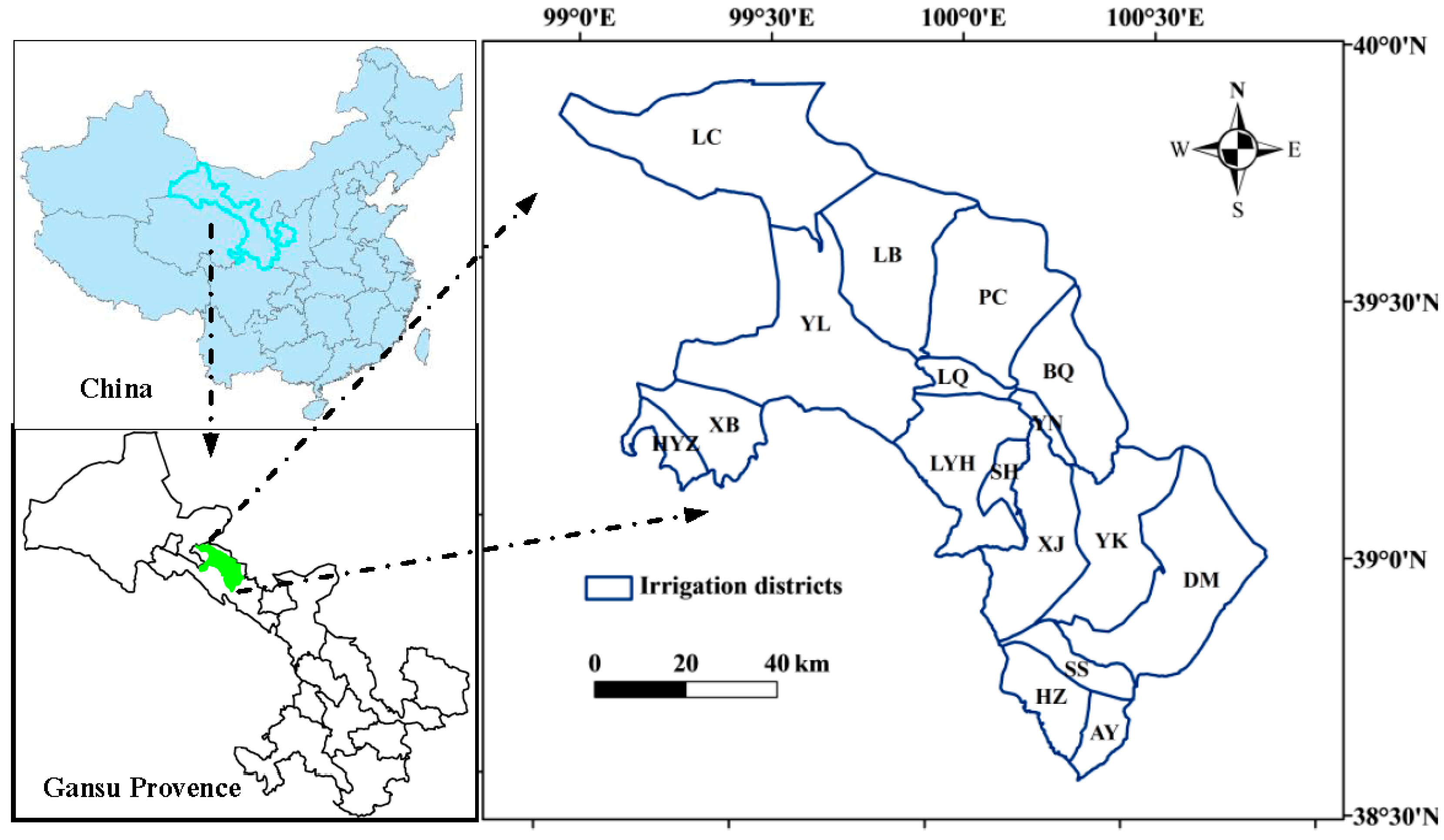
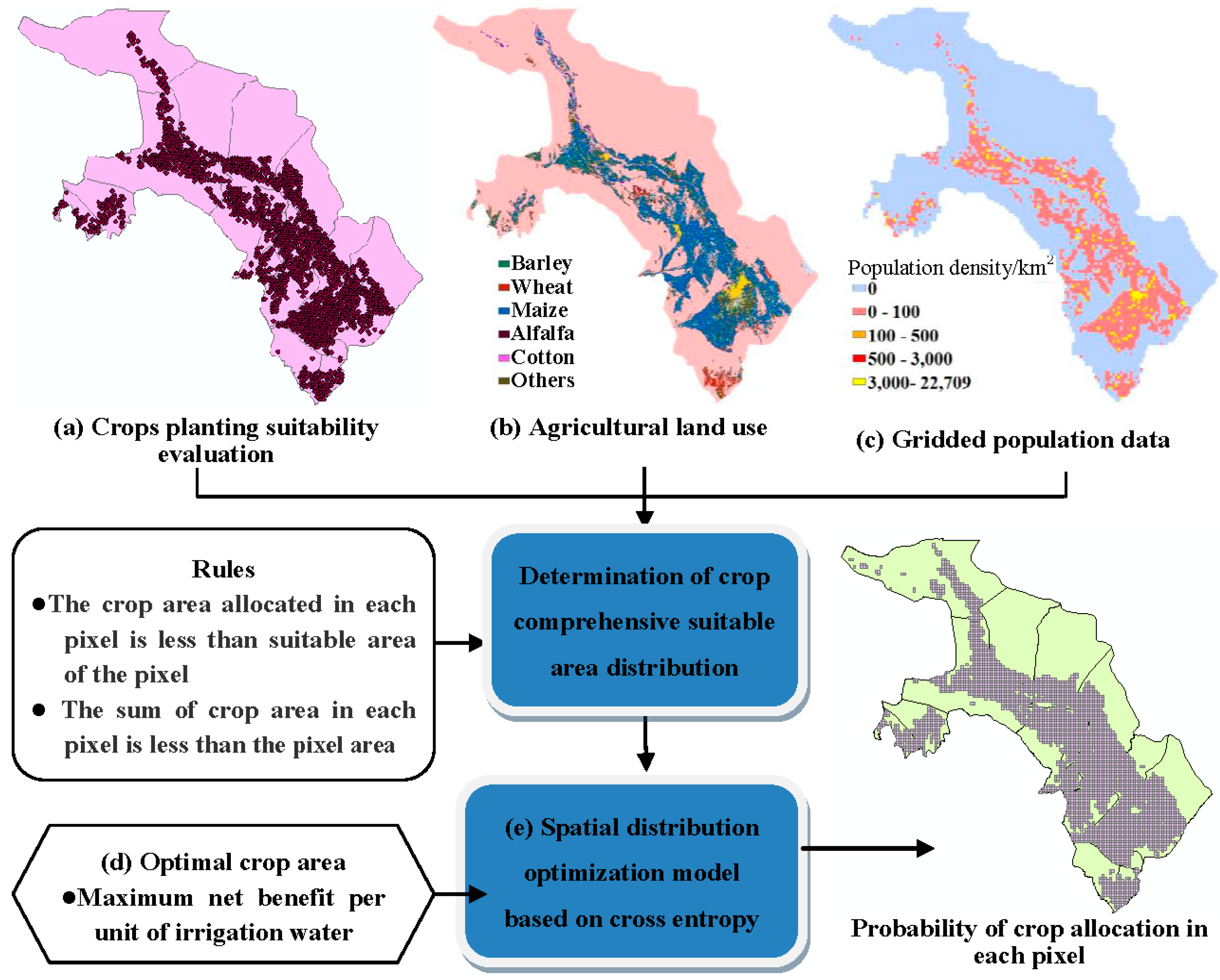
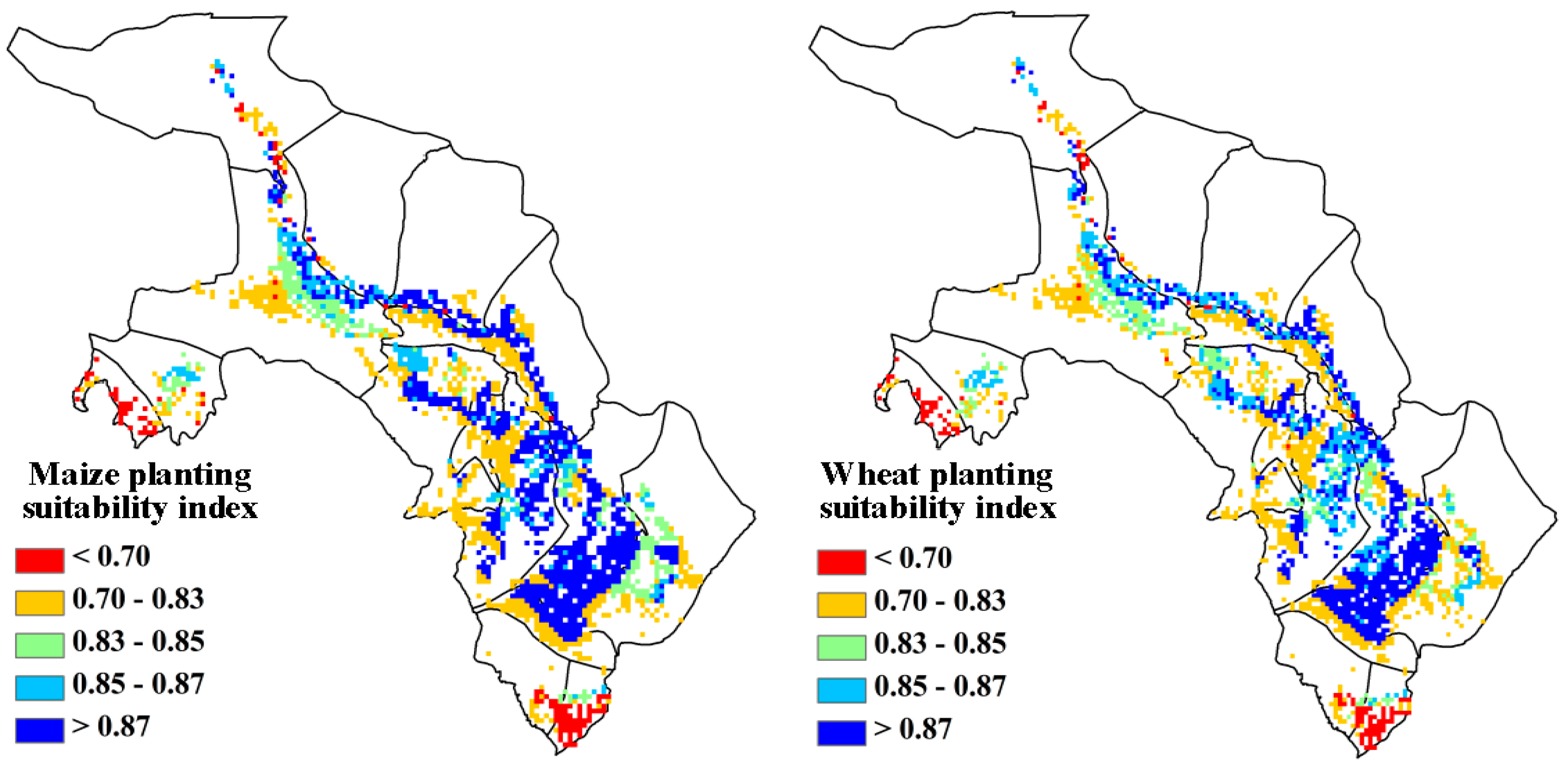
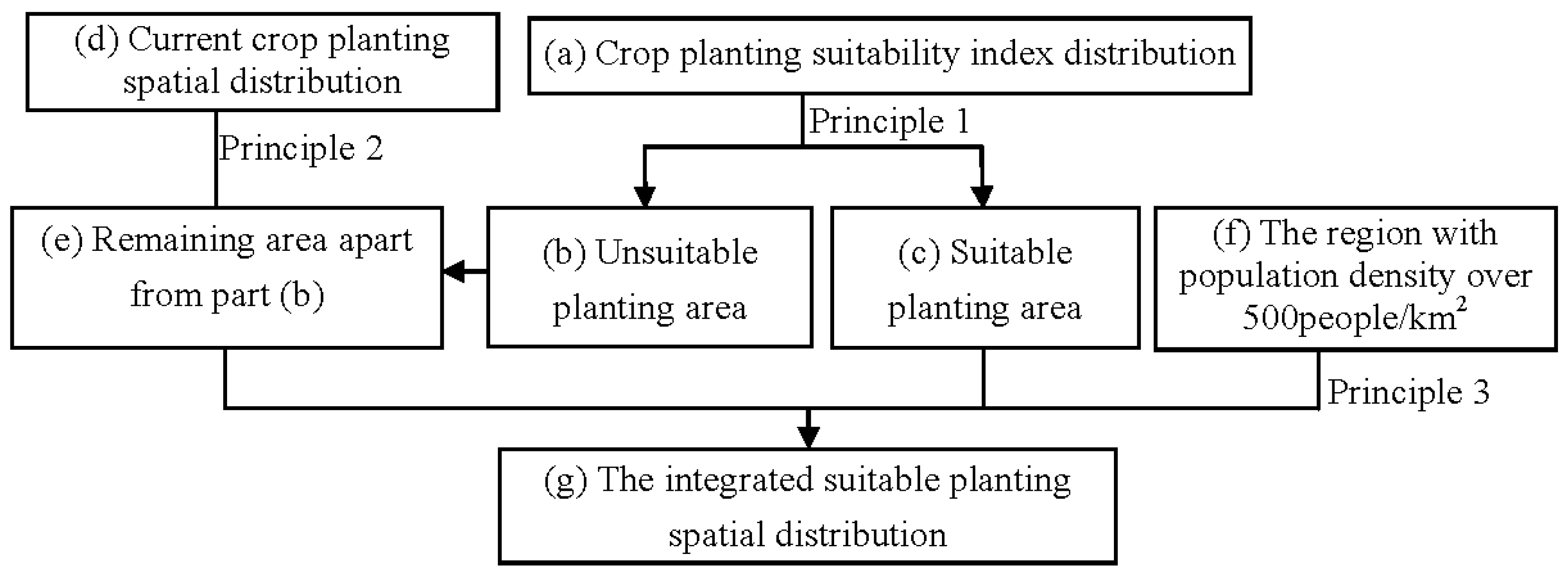
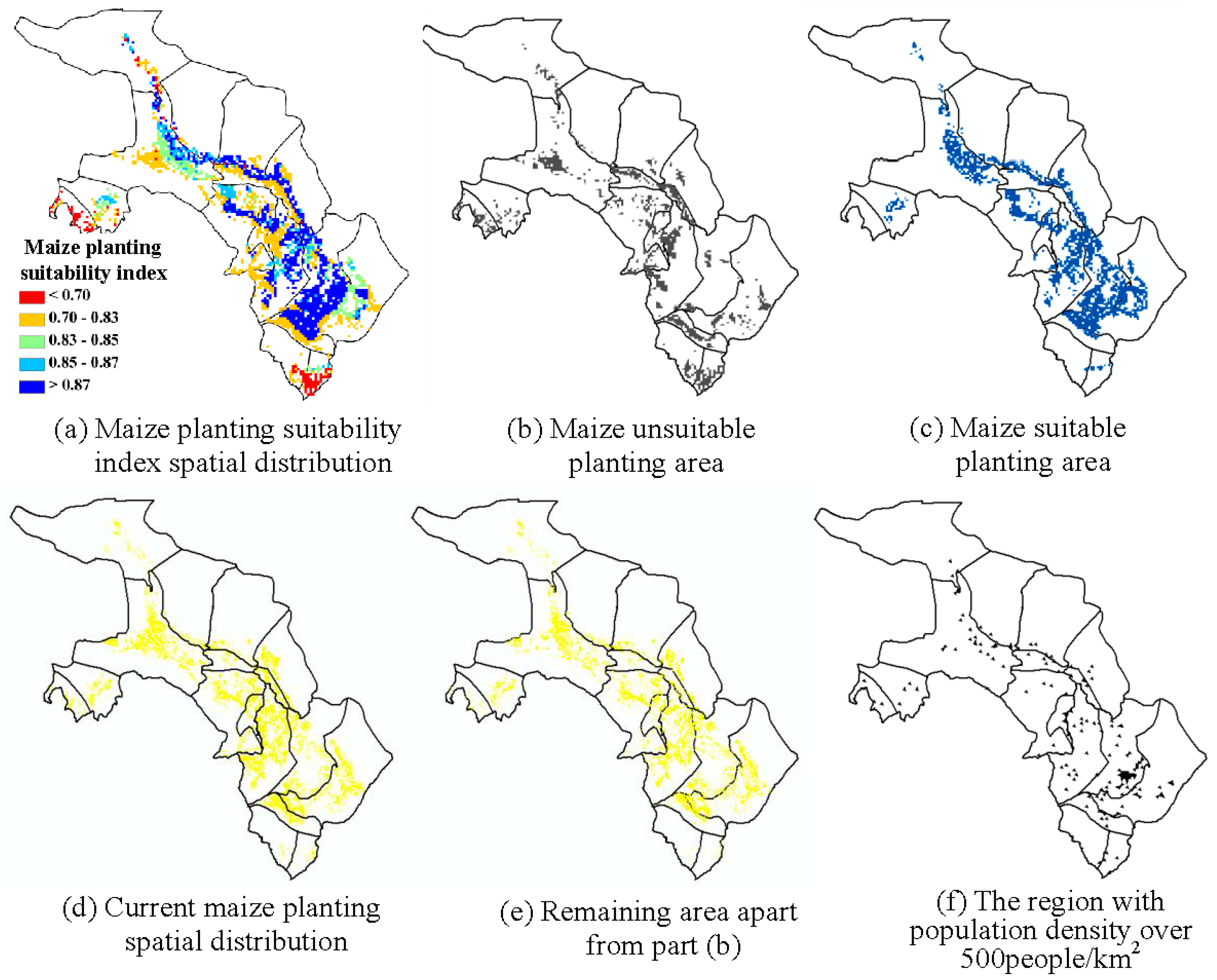
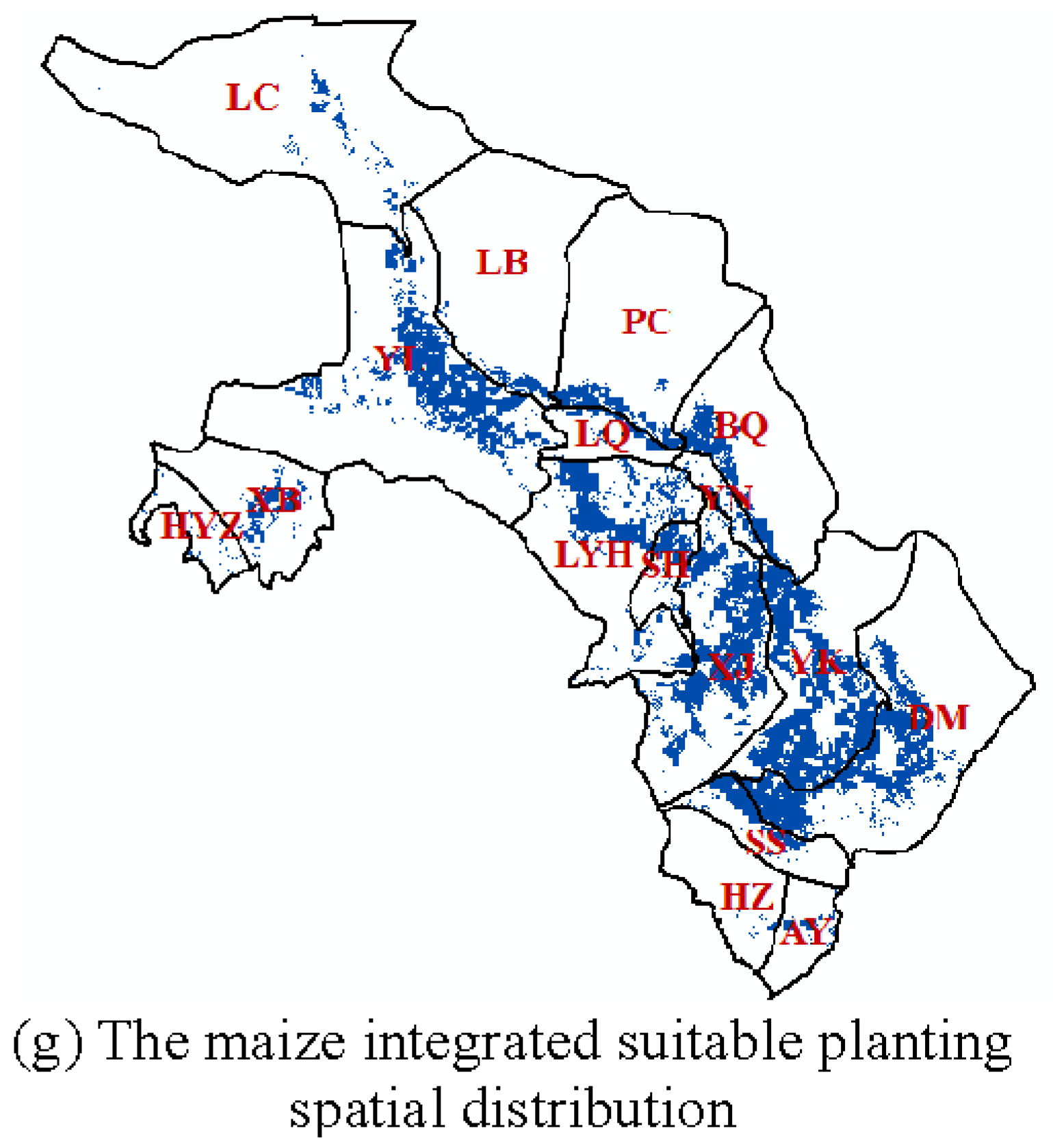
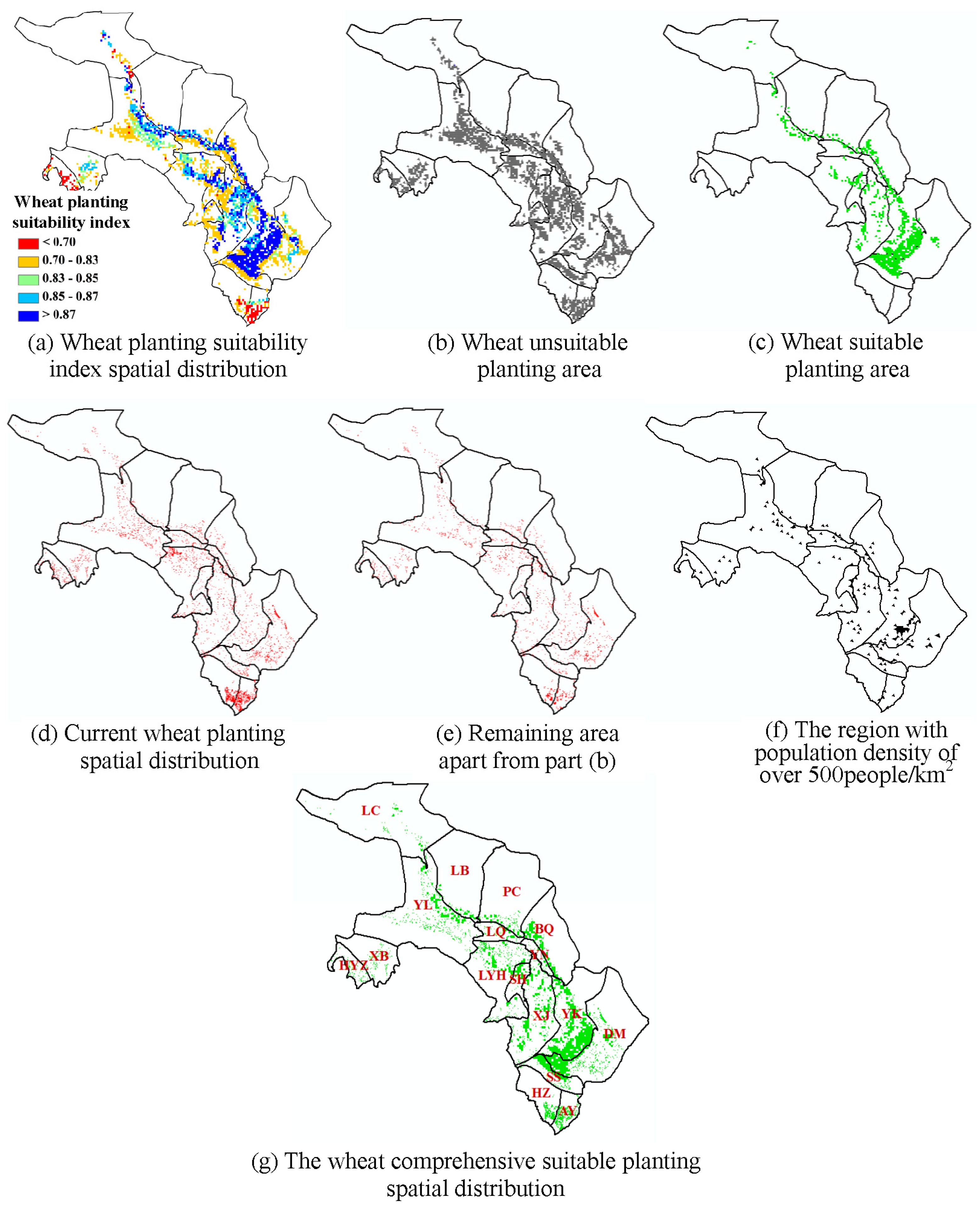
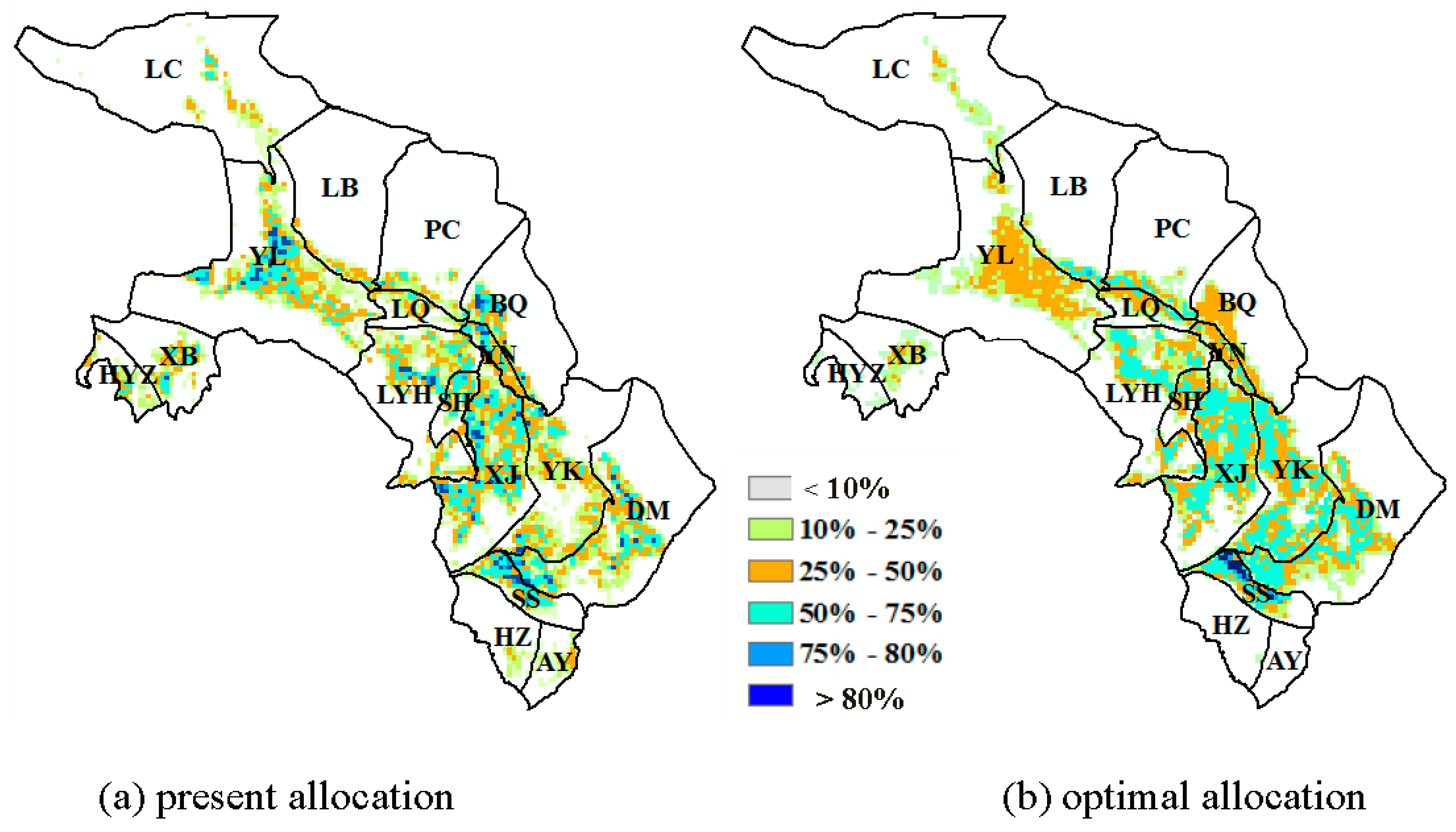

| Maize | Wheat | Potato | Seed Maize | Cotton | Oil Crops | Vegetable | Sum | |
|---|---|---|---|---|---|---|---|---|
| Actual situation | 19,680 | 14,241 | 794 | 75,252 | 3573 | 1116 | 11,258 | 125,915 |
| Optimization | 14,111 | 12,818 | 725 | 82,785 | 4174 | 990 | 10,375 | 125,977 |
| Irrigation Districts | Maize | Wheat | ||
|---|---|---|---|---|
| Actual Situation | Optimization | Actual Situation | Optimization | |
| DM | 11,805 | 14,614 | 160 | 167 |
| YK | 15,049 | 17,106 | 1053 | 1067 |
| XJ | 17,598 | 17,567 | 579 | 400 |
| SS | 6474 | 6421 | 87 | 78 |
| AY | 13 | 18 | 561 | 545 |
| HZ | 0 | 30 | 353 | 199 |
| PC | 3013 | 3000 | 1180 | 1268 |
| LQ | 2367 | 2433 | 1253 | 749 |
| BQ | 3900 | 3931 | 167 | 204 |
| YN | 2113 | 2331 | 947 | 679 |
| SH | 2873 | 2210 | 1007 | 924 |
| LYH | 10,220 | 10,433 | 3707 | 3850 |
| YL | 14,540 | 12,412 | 867 | 800 |
| LB | 1880 | 1882 | 56 | 52 |
| LC | 1400 | 1303 | 13 | 73 |
| XB | 1593 | 1080 | 640 | 585 |
| HYZ | 93 | 125 | 1613 | 1177 |
| Sum | 94,932 | 96,896 | 14,241 | 12,817 |
| Maize Planting Suitability Index | 0.83–0.84 | 0.84–0.85 | 0.85–0.86 | 0.86–0.87 | 0.87–0.88 | 0.88–0.89 | 0.89–0.9 | 0.9–0.92 | Sum |
|---|---|---|---|---|---|---|---|---|---|
| Area (ha) | 11,295 | 8242 | 7006 | 11,579 | 30,977 | 22,851 | 8899 | 2486 | 103,337 |
| Wheat Planting Suitability Index | 0.88–0.89 | 0.89–0.90 | Sum |
|---|---|---|---|
| Area (ha) | 16,942 | 3373 | 20,315 |
© 2017 by the authors. Licensee MDPI, Basel, Switzerland. This article is an open access article distributed under the terms and conditions of the Creative Commons Attribution (CC BY) license (http://creativecommons.org/licenses/by/4.0/).
Share and Cite
Hao, L.; Su, X.; Singh, V.P.; Ayantobo, O.O. Spatial Optimization of Agricultural Land Use Based on Cross-Entropy Method. Entropy 2017, 19, 592. https://doi.org/10.3390/e19110592
Hao L, Su X, Singh VP, Ayantobo OO. Spatial Optimization of Agricultural Land Use Based on Cross-Entropy Method. Entropy. 2017; 19(11):592. https://doi.org/10.3390/e19110592
Chicago/Turabian StyleHao, Lina, Xiaoling Su, Vijay P. Singh, and Olusola O. Ayantobo. 2017. "Spatial Optimization of Agricultural Land Use Based on Cross-Entropy Method" Entropy 19, no. 11: 592. https://doi.org/10.3390/e19110592





